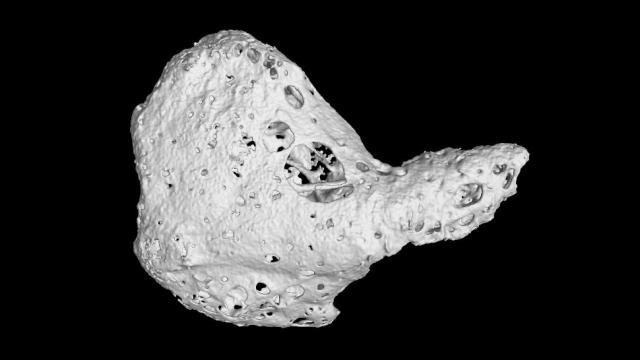Scientists in the United Kingdom have discovered a rare bone, called the os cordis, in chimpanzees with a common heart condition. The implications of this finding could extend to humans, who share a close genetic relationship to chimps.
Cattle, buffalo, and sheep have it. So do otters, camels, and dogs. Primates, not so much ” at least that’s what scientists thought.
The os cordis, a small bone found in the hearts of certain animals, is also present in some chimpanzees, according to research published today in Scientific Reports. It’s the first time os cordis has been detected in a great ape species.
The rare bone structure was mostly found in chimps suffering from idiopathic myocardial fibrosis (IMF), in which the heart develops potentially life-threatening scar tissue. IMF is common in many animals, including chimps and humans. The unexpected discovery could lead to better treatments for chimpanzees, a species for which cardiovascular disease is common. What’s more, the research, led by the University of Nottingham’s School of Veterinary Medicine and Science, could apply to humans as well, given how closely related we are to chimpanzees.
“The discovery of a new bone in a new species is a rare event, especially in chimps which have such similar anatomy to people,” said Catrin Rutland, a co-author of the study, in a University of Nottingham press release. “It raises the question as to whether some people could have an os cordis, too.”
For the new study, 16 chimpanzees, some with IMF and some without, had their hearts scanned with x-ray microcomputed tomography. No animal needed to be killed, as all chimps died of natural causes in European zoos. The scans generated clear, high-resolution images showing the tiny os cordis, which measures just a few millimetres across.
For anatomy nerds out there, this “hyperdense” bone structure was found inside the right fibrous trigone. Simply described, this meaty part of the heart forms a link between the aortic, mitral, and tricuspid valves.
Some chimp hearts also exhibited cartilago cordis, that is, cartilage formation. This is an important discovery, because the cartilage might have something to do with the growth of the rare bone structure, as cartilage has the potential to turn into bone.
“Three of our 16 chimps had an os cordis and one had an os cartilago, and all four were severely affected by IMF,” explained Rutland to Gizmodo in an email. “The other 12 chimps did not have an os cordis or os cartilago but had lower levels of fibrosis or no fibrosis at all. So we linked having an os cordis to more severe fibrosis. Both male and female, young and old chimps could have the os cordis, so sex and age did not make a difference, although in general older chimps are more likely to have more severe IMF.”
As noted, the presence of os cordis in chimps is giving rise to suspicions that it may also appear in humans under similar circumstances. As the authors note in their study:
However, it should be noted that not all chimpanzees affected with IMF had os/cartilago cordis, therefore it may serve as an indicator rather than diagnosis tool. The possibility of os cordis and cartilago cordis occurring in humans suffering from similar cardiovascular disorders should be considered. In conclusion this new discovery of both os cordis and a cartilago cordis, in the chimpanzee heart highlights the need for further cardiovascular investigations in this and other species including humans using the latest technologies in order to gain valuable clinical and anatomical knowledge.
It’s worth noting that correlation is not causation. The link between IMF and os cordis still needs to be sorted out. And of course, this strange bone has never been detected in humans ” arguably the most studied animal on the planet. To suddenly find this rare bone structure in human hearts would be a surprise, but perhaps it’s something scientists have overlooked.
Finding new parts of the human anatomy or previously undetected physiological processes is rare, but it regenerate body parts.
